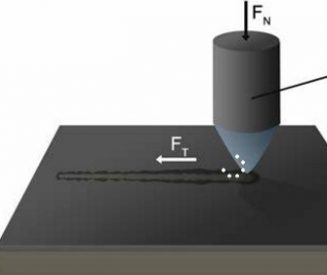Scratch testing is without a doubt the most widely used and popular approach in the assessment of the adhesion strength of a coating-substrate system.Scratch testing is invaluable to gain insight into materials such automotive paints, varnishes, as well as coatings. Single asperity scratching allows the mechanisms behind abrasive or ductile damage to be understood without the complexity of multiple asperity contacts.
 Applications of Scratch Testing:
Applications of Scratch Testing:
- Commercial polymers
- Paint and varnishes for the automotive industry
- Multilayered systems
- Application related performance
Scratch testing consists of using a hard metal or diamond spherical tipped indenter (typically with a radius of 200 μm) to apply an increasing load on the coating surface continuously while the sample is displaced at a constant velocity. Scratching of the surface results in increasing elastic and plastic deformation until extensive spalling of the coating from the substrate occurs at some critical load (Lc). In general, the critical load is determined by acoustic emission, friction force measurements, or optical microscopy.
 Applications of Scratch Testing:
Applications of Scratch Testing: